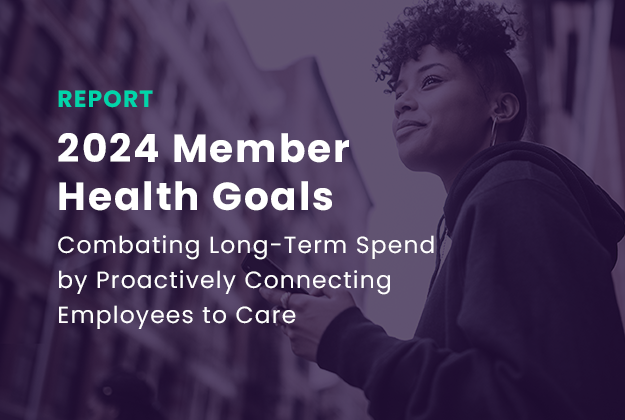2024 Member Health Goals
The second annual Member Health Goals report harnesses the power of data to help discover the differences between the type of benefits employees...
Connected Navigation Platform
Guiding to high-value care
Behavioral Health
Foster a mentally healthy workplace
EAP
Supporting holistic wellbeing
Virtual MSK Care
Reimagining musculoskeletal care
Virtual Primary Care
Powered by smart navigation
Surgery Centers of Excellence
Best-in-class surgical outcomes
Virtual Urgent Care
Immediate care, any hour of the day
Chronic Care
A new approach to chronic care
Integrations
Flexible to any strategy

US employers are preparing for the largest increase in health insurance costs in a decade in 2024. With healthcare costs continuing to climb, as well as an increased focus on efficient healthcare spending, more employers have turned to point solutions.
Point solutions are a convenient way — often an app or digital tool — for brokers and employers to fill gaps in the benefits they offer. In fact, point solutions are becoming a core component of many benefit strategies with 50% of organizations offering between four and nine solutions.
As a result of the rapid growth and innovation in this space, thousands of new vendors have entered the employee benefit point solution marketplace in the past decade.
And with cost containment top of mind this year, it’s more important than ever to vet these solutions. Doing so will allow you to understand their capabilities and how they can positively impact your clients’ benefit strategies.
Finding the best fit for your clients can be a challenge, but assembling a comprehensive package of point solutions can make a huge difference in annual healthcare spend.
With that in mind, let’s take a look at eight key areas to consider when evaluating point solutions.
With thousands of point solutions available on the market, and all of their innovative features, it can be difficult to cut through the noise. A good starting place in any evaluation is thinking about who will find the solution helpful.
On the organizational side, consider:
On the user side, consider:
Asking these questions can provide perspective and uncover value that both organizations and their employees will appreciate.
Communication and simplicity are critical when partnering with HR teams. Consider how the point solution works with the HR team to ensure a smooth launch and produce successful outcomes.
Read reviews and ask questions to see what the implementation process looks like, and make sure the company has comprehensive support available on an ongoing basis.
Look for live support numbers, service level agreements and member satisfaction scores. You can also review the structure of their customer service team to make sure they’re able to assist with any client challenges that may arise. This can be the difference between having a dedicated account manager or waiting on hold when reaching out to customer support lines.
Just like adding a new menu item at a restaurant, you want to make sure new point solutions match the rest of your benefits “menu.”
By considering the broader ecosystem, integrations and your other partnerships, you can add point solutions that create the most impactful, integrative offering possible.
Remember not all integrations are the same. Certain point solutions only work with certain health plans, TPAs and benefit administrators.
Investigate what data the point solution is utilizing to better understand a given member or a population.
A few questions to ask include:
Also, take into account the recency of the data they’re using and whether it’s coming from a direct feed with a TPA or from a data warehouse.
Even though member experience is number five on this list, it’s as important as any area to evaluate! Without a strong member experience, it’s difficult to reach the engagement levels necessary to justify the expense of adding a point solution.
Consider the following questions related to engagement:
Have you ever waited on the phone for an hour to solve a problem that took 30 seconds to resolve? If you answered yes, like most of us, then you know how important the human element is! It can be frustrating to have to wait for resolutions, especially when they are related to benefits that employees count on.
According to Forbes, 86% of consumers prefer to interact with a human agent and 71% said they would be less likely to use a brand if it didn’t have human customer service representatives available.
Consider whether your clients will have access to human concierge services, have a dedicated representative, or will be calling a support line. Also, look at their hours of availability to see if you’ll have 24/7 support or be stuck to “normal working hours” for support.
More times than not, a point solution’s ability to bolster your benefit strategies and your clients’ bottom line will be the primary focus.
Beyond ROI and other key business metrics, be sure to inquire about how reporting is handled.
You can ask questions like:
Ensuring a high degree of transparency is of paramount importance when evaluating results and performance.
If you want to dig even deeper explore:
Put plain and simple: will this solution grow with you?
Does this solution (and the company behind it) have the right vision and infrastructure to continue adding value to your suite of offerings?
Be sure to look beyond the solution in its current stage. Ask about their roadmap and review other pertinent materials to see if they have a plan to continue innovating.
When evaluating through the lens of cost containment, you can find solutions that provide true value to all parties involved, deliver results and ensure the best experience possible.
No matter what point solution you’re considering, a thorough evaluation process ensures your clients feel secure about your ability to provide the best offerings and experience possible.
Regardless of how many different point solutions exist in your benefits package, HealthJoy makes all benefits – regardless of vendor – feel like a single experience for employees.
We bring benefit strategies to life and help HR teams — and their partners — better control long-term healthcare spend. If you’re interested in learning more about how HealthJoy can help tackle current and future healthcare costs, we’d love to connect!

The second annual Member Health Goals report harnesses the power of data to help discover the differences between the type of benefits employees...

This renewal season isn’t just another tough cycle—it’s a client retention crisis in the making. While national headlines forecast a modest 6-9%...

Every year, companies must decide on how much they’ll need to change their existing employee benefits. As annual rates increase, it can be...